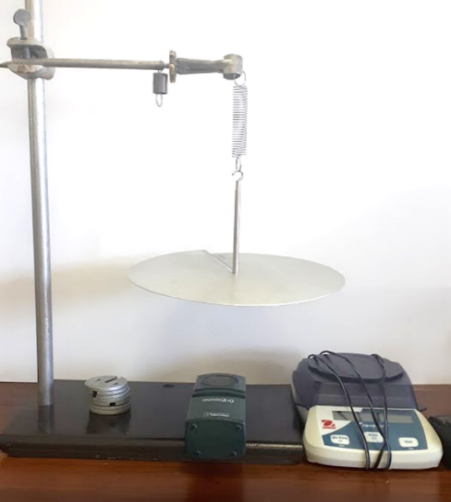- Home
- Semester and Timetable Information
- Study Physics
- Our Research
- Our People
- Careers and Alumni
- Seminars, News and Events
- Outreach and School Resources
- About the School
- What is Physics
- The Crawford Observatory
- Frequently Asked Questions
- UCC Futures Quantum & Photonics
- Supports
Harmonic Motion
There is two parts to this experiment.
Part 1: Simple Harmonic Motion
If a mass M hanging from a massless string is pulled vertically downwards from its equilibrium position (stable position), the spring applies a force called a restoring force. As discovered in Experiment 3 Hookes Law, this restoring force is related to the extension from the equilibrium position according to the relationship F = -kx, where F is the restoring force, k is the spring constant and x is the extension of the mass from the equilibrium position. The negative sign means that F is in the opposite direction to x. If the mass is then released it accelerates towards the equilibrium position. From Newton’s Second Law of Motion, the acceleration of a mass M under the influence of a force F is given by a = F / m. Combining both of these force equations, results in an acceleration given by
a = – (k/M)*x
As the mass reaches its equilibrium position (x = 0) there is no net force on it (its weight being exactly balanced by the upward force exerted by the spring) and hence the acceleration is zero. At this point, however, its momentum causes it to overshoot its equilibrium position and, as it continues to move upwards away from the equilibrium position, the restoring force exerted by the spring becomes progressively less than its weight, thereby causing it to decelerate. Thus the velocity must become zero at some point (x = A), at the opposite side from the initial starting position. Next the mass begins to move once again towards the equilibrium position and overshoots as before. This continuous up and down movement is an example of simple harmonic motion.
See this guided lab for a visual represetation of how this lab is carried out.
Part 2: Damped Harmonic Motion
In part 1 the amount of damping is very small. On the other hand, if some of the added mass on the weight hanger is replaced by a metal disc of similar mass and of reasonably large area, air resistance will make a measurable contribution to the dynamics of the system. The mass attached to the spring will now execute damped harmonic motion.

For part 1 & 2 the motion of the masses and springs is measured using the same motion sensor used in exp 5 Coefficient of Friction. The motion sensor is placed below the masses and a graph of the position vs time is created.
If you want to explore the concepts of harmonic motion try you hand with these online labs / simulations:
This oscillations lab shows the distance time graph achieved for harmonic motion. You can change the spring constant, the mass on the hanger and even acceleration due to graity and se i's effects on the harmonic motion on the distnce vs time graph.
This helical spring online lab shows how to carry out the lab without the uses of a motion sensor.
This Horizontal Oscillations with Damping Lab is different from the lab carried out as it places the sping on the horizontal and uses the force of a moving puck to cause the oscillations to begin. In our experimentthe spring is in the vertical orientation and the use of the force gravity on a massis used to cause the oscillations. However this online lab does give a very good example of how dampening change the position vs time graph of harmonic motion. You can see the effect of the dampening on reducing the energy in the system.
